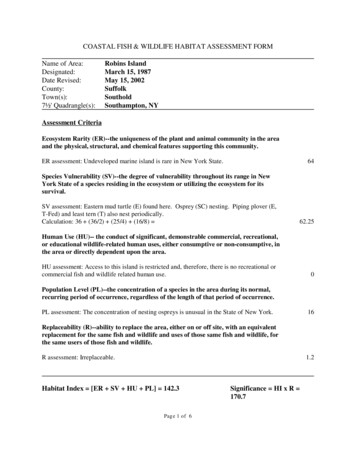
Transcription
COASTAL FISH & WILDLIFE HABITAT ASSESSMENT FORMName of Area:Designated:Date Revised:County:Town(s):7½' Quadrangle(s):Robins IslandMarch 15, 1987May 15, 2002SuffolkSoutholdSouthampton, NYAssessment CriteriaEcosystem Rarity (ER)--the uniqueness of the plant and animal community in the areaand the physical, structural, and chemical features supporting this community.ER assessment: Undeveloped marine island is rare in New York State.64Species Vulnerability (SV)--the degree of vulnerability throughout its range in NewYork State of a species residing in the ecosystem or utilizing the ecosystem for itssurvival.SV assessment: Eastern mud turtle (E) found here. Osprey (SC) nesting. Piping plover (E,T-Fed) and least tern (T) also nest periodically.Calculation: 36 (36/2) (25/4) (16/8) 62.25Human Use (HU)-- the conduct of significant, demonstrable commercial, recreational,or educational wildlife-related human uses, either consumptive or non-consumptive, inthe area or directly dependent upon the area.HU assessment: Access to this island is restricted and, therefore, there is no recreational orcommercial fish and wildlife related human use.0Population Level (PL)--the concentration of a species in the area during its normal,recurring period of occurrence, regardless of the length of that period of occurrence.PL assessment: The concentration of nesting ospreys is unusual in the State of New York.16Replaceability (R)--ability to replace the area, either on or off site, with an equivalentreplacement for the same fish and wildlife and uses of those same fish and wildlife, forthe same users of those fish and wildlife.R assessment: Irreplaceable.1.2Habitat Index [ER SV HU PL] 142.3Pag e 1 of 6Significance HI x R 170.7
NEW YORK STATESIGNIFICANT COASTAL FISH AND WILDLIFE HABITATNARRATIVEROBINS ISLANDLOCATION AND DESCRIPTION OF HABITAT:Robins Island is situated between Great and Little Peconic Bays, Long Island. This island liesapproximately one and one-quarter miles southwest of Little Hog Neck, in the Town of Southold,Suffolk County (7.5' Quadrangle: Southampton, NY). Robins Island is an undeveloped marineisland, approximately 450 acres in size. It includes approximately four miles of stony beach,several freshwater and tidal saltwater marshes, an island pond and bog, mature wooded areas,grassland and maritime shrublands. The island is privately owned with a protective easement onall land except pre-existing built areas, and one new single family house.FISH AND WILDLIFE VALUES:Undeveloped marine islands of this size are rare in New York State. Robins Island provides asecluded habitat for a variety of wildlife species, including several endangered and threatenedspecies. The New York Natural Heritage Program has documented occurrences of a number ofrare plants and ecological communities on the island, including salt-marsh spikerush, purpleeverlasting, seabeach knotweed, and the coastal salt pond community.Osprey (SC) nests have often been observed on the shores of the island with 8 active nest sitescurrently documented. Robins Island is the only area on Long Island where osprey are known tonest on natural structures rather than man-made platforms.Least terns (T), roseate terns (E), and common terns (T) were reported nesting on the island'sbeaches in 1976; however, only least tern have been documented since then. Small numbers ofleast tern nested here on two occasions in the late 1980s. In 1996, 206 pairs of this species weredocumented. Piping plover (E, T-Fed) have nested sporadically and in small numbers (1-2 pairs)since the mid-1980s.During the 1970s and early 1980s, black-crowned night herons, snowy egrets, yellow-crownednight herons, and green herons nested in an extensive heronry which is no longer present. Thesespecies still feed in and around the marshes located at the northwestern end of Robins Island.Red-tailed hawks and great-horned owls may also nest on the island. Shorebirds utilize theshores and marshes as feeding grounds during migration, including black-bellied plover, ruddyturnstone, lesser yellowlegs, greater yellowlegs, sanderling, and semi-palmated sandpiper. TheRobins Island nearshore area is an important overwintering area for populations of Americanblack duck, and for sea ducks such as white-winged scoter, surf scoter, and black scoter. Acolony of bank swallows nest in the sandy bluffs located on the western shoreline of the island.Approximately 400 acres of upland oak-hickory woods provide habitat for a variety of passerinebirds and a population of white-tailed deer.Pag e 2 of 6
Wetlands on the island support one of the best populations of eastern mud turtle (Kinosternonsubrubrum, E) in New York State. Spotted salamander are also found on Robin’s Island.The waters in the vicinity of Robins Island provide an important recreational fishery and lobsterharvest, as well as some scallop harvesting opportunities. However, because access is restricted,there is currently no recreational use of the island itself.IMPACT ASSESSMENT:Human disturbance of any part of Robins Island, including the beaches, marshes or woodlandswould adversely affect the wildlife species which nest and feed on and around this almostuninhabited island. Any activity affecting the water quality in this area would adversely impactthe bay scallop and other fisheries here.Any alteration of hydrology on the island, such as artificial openings to the bay or waterdiversions for construction or other activities, could negatively impact the rare coastal salt pondhabitat. Elimination of open water or wetland areas, through excavation, filling, or shorelinehardening, would result in a direct loss of valuable habitat in coastal ponds and other habitats onthe island. Alternative strategies for the protection of shoreline property should be examined,including innovative, vegetation-based approaches. Control of invasive nuisance plant species,through a variety of means, may improve fish and wildlife species use of the area and enhanceoverall wetland values.Nesting shorebirds inhabiting Robins Island are highly vulnerable to disturbance by humans,especially during the nesting and fledging period (March 15 through August 15). Significantpedestrian traffic or recreational vehicle use of the beach could easily eliminate the use of thissite as a breeding area and should be minimized during this period. Recreational activities (e.g.,boat and personal watercraft landing, off-road vehicle use, picnicking) in the vicinity of birdnesting areas should be minimized during this period. Predation of chicks and destruction ofeggs or nests by unleashed pets (e.g., dogs, cats) and natural predators may also occur, andpredator control should be implemented where feasible. Fencing and/or continued annualposting of shorebird nesting areas should be provided to help protect these species. Control ofvegetative succession, through beneficial use of dredged material or other means may improvethe availability of nesting habitat in this area.The feasibility of restoring historical nesting bird populations on the island, such as common ternand roseate tern populations and the diverse heronry should be studied.Pag e 3 of 6
KNOWLEDGEABLE CONTACTS:Habitat UnitNYS Department of StateDivision of Coastal Resources41 State StreetAlbany, NY 12231Phone: (518) 474-6000NYSDEC—Region 1State University of New York, Building 40Stony Brook, NY 11790-2356Phone: (631) 444-0354Wildlife ManagerNYSDEC—Region 1State University of New York, Building 40Stony Brook, NY 11790Phone: (631) 444-0310Bureau of Marine ResourcesNYSDEC205 N. Belle Meade Road, Suite 1East Setauket, NY 11733Phone: (631) 444-0430New York Natural Heritage ProgramWildlife Resources Center700 Troy-Schenectady RoadLatham, NY 12110Phone: (518) 783-3932Town of SoutholdTown Hall53095 Main Road; P.O. Box 1179Southold, NY 11971Phone: (631) 765-1801Office of EcologySuffolk County Dept. of Health ServicesBureau of Environmental ManagementCounty CenterRiverhead, NY 11901Phone: (631) 852-2077Pag e 4 of 6
Cornell Cooperative ExtensionMarine Program3690 Cedar Beach RoadSouthold, NY 11971Phone: (631) 852-8660Mike ScheibelThe Nature ConservancyMashomack Preserve79 South Ferry RoadShelter Island, NY 11964Phone: (631) 749-1637Norman SouleCold Spring Harbor Fish HatcheryP.O. Box 535Cold Spring Harbor, NY 11724Phone: (631) 692-6768Paul Stoutenburgh4015 Skunk LaneCutchogue, NY 11935Phone: (631) 734-6605Pag e 5 of 6
To print on 8.5 x 11 set printer to Fit to Print or reduce by 64%Page 6 of 6
State University of New York, Building 40 Stony Brook, NY 11790-2356 Phone: (631) 444-0354 Wildlife Manager NYSDEC—Region 1 State University of New York, Building 40 Stony Brook, NY 11790 Phone: (631) 444-0310 Bureau of Marine Resources NYSDEC 205 N. Belle Meade Road, Suite 1 East Setauket, NY 11733 Phone: (631) 444-0430
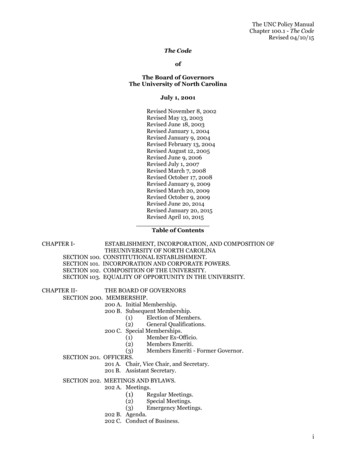
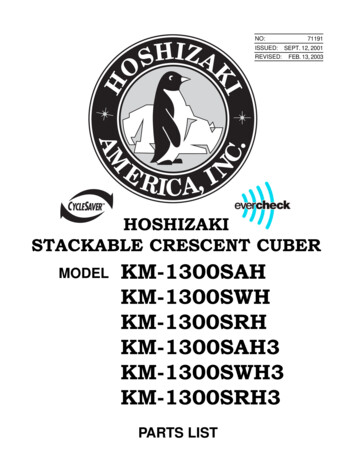

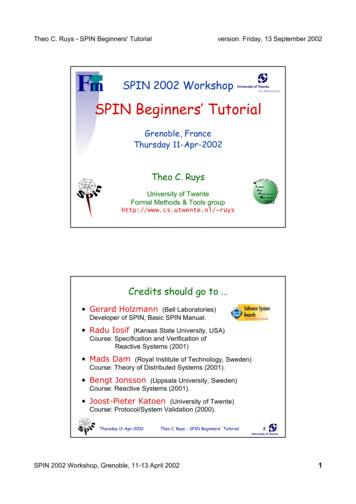
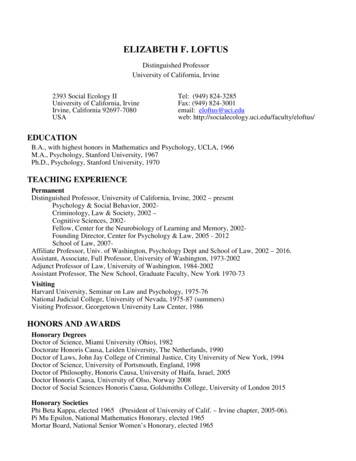
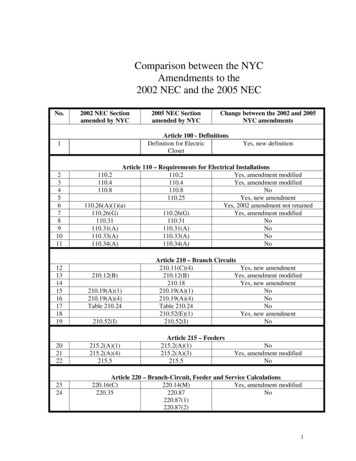
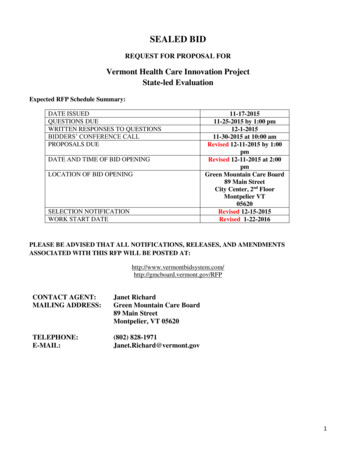
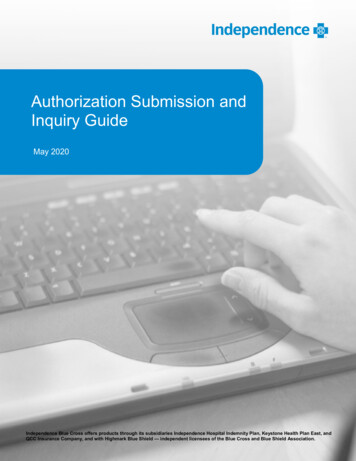
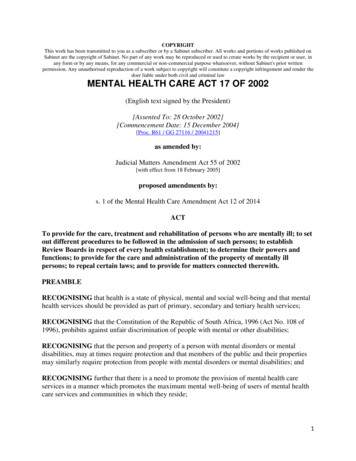

![Immigration Act [No. 13 of 2002] - Gov](/img/30/a13-020.jpg)
![firearms qualifications [PFP#730045656]](/img/59/firearms2003.jpg)